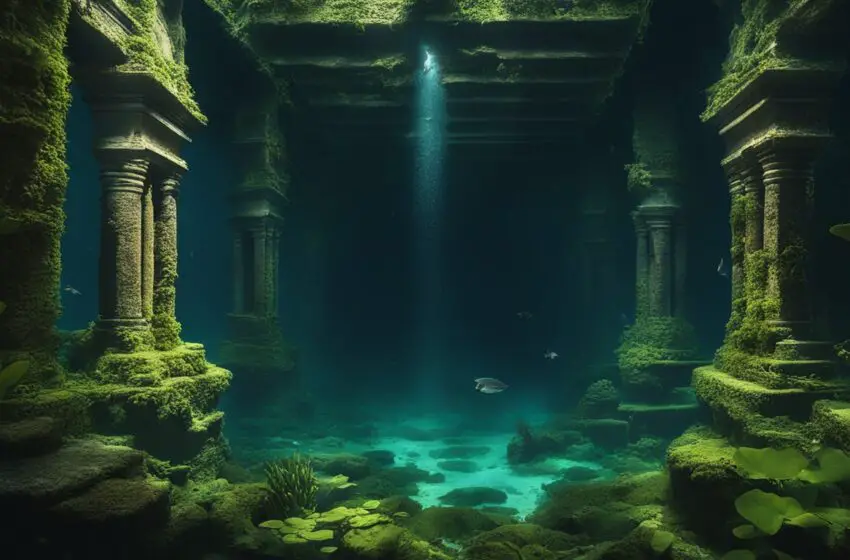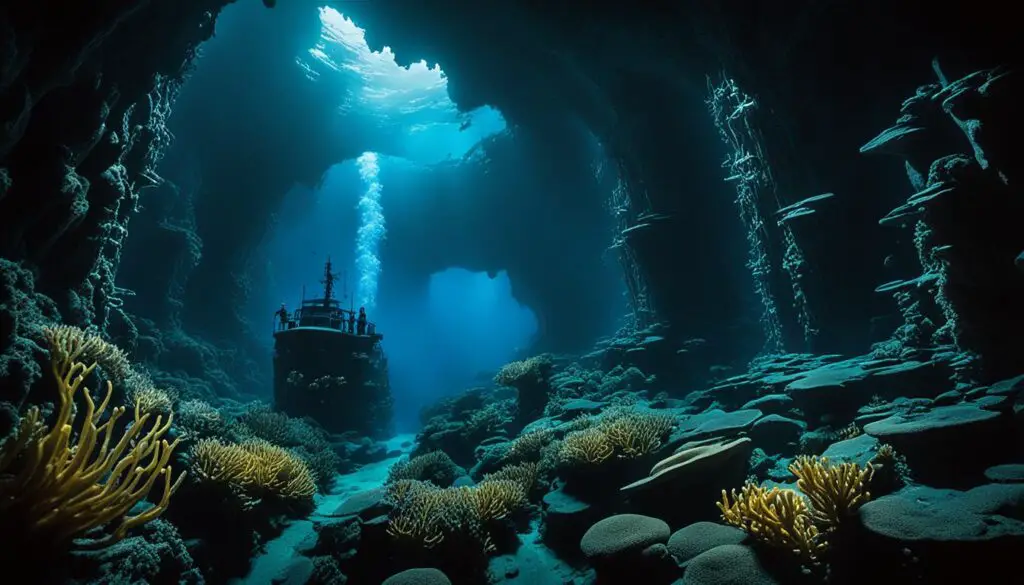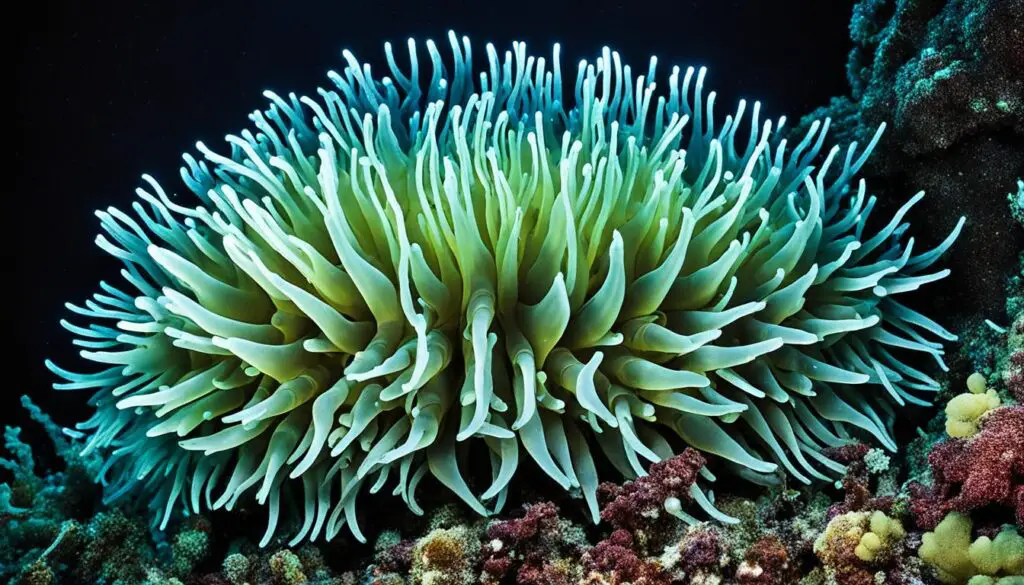Deep Sea Mysteries: Unraveling the Enigma: Delving into Deep Sea Mysteries!

Let’s dive into the deep sea’s mesmerizing world. We’ll explore its enigmatic depths where countless secrets are kept. The deep sea is not only home to mysterious creatures but also hidden wonders.
This captivating realm holds countless secrets. And it’s waiting for us to discover its awe-inspiring beauty and fascinating finds. Join me in this extraordinary journey into the deep sea.
Key Takeaways:
- The deep sea is a mysterious realm that holds countless secrets and hidden wonders.
- Exploring the deep sea requires specialized equipment and rigorous training.
- The deep sea is home to a wide variety of bizarre and unique creatures with extraordinary adaptations.
- Scientific discoveries in the deep sea have expanded our understanding of the planet and its potential.
- Conservation efforts are crucial to protect and preserve the fragile ecosystem of the deep sea.
Descending into the Abyss: Challenges and Wonders of Deep-Sea Exploration
The adventure starts as we move deep into the ocean, leaving the known world above. Journeying through ocean depths is tough, needing us to face many challenges. We must prepare well, using special gear for the pressure and getting trained.
Exploring the deep sea is a skilled task. It means moving in the dark, in very cold water, and under huge pressure. Scientists and explorers train hard to stay safe and succeed.
Training helps them get ready for the mysterious depths. They learn to use special tools and find their way around. They also study the deep sea’s complex life.
But, there are more challenges than just what we face physically. Scientists must plan well to reach remote areas and map the deep ocean. It’s a big job to understand this vast, mysterious world.
Yet, the discoveries under the sea make the effort worth it. We’ve found amazing landscapes, fascinating marine life, and special rocks and earth formations. We’ve also learned about new species that survive in extreme places, showing us life’s amazing adaptability.
Studying the ocean’s deep parts is very interesting. It tells us about the behavior of deep-sea life and how the ocean floor changes. This helps us learn about our planet’s history and how it’s still changing.
“The exploration of the deep sea is like exploring an alien planet right here on Earth. It’s both a humbling and awe-inspiring experience to witness firsthand the incredible diversity and sheer beauty that lies beneath the surface.”
Dr. Maya Johnson, Deep-Sea Explorer and Marine Biologist

Preparations for Deep-Sea Exploration
| Challenges | Solutions |
|---|---|
| Extreme water pressure | Specialized equipment designed to withstand high pressure |
| Darkness | Advanced lighting systems and sonar technology |
| Extreme temperatures | Insulated diving suits and temperature-controlled equipment |
| Logistical hurdles | Collaboration between research institutions and expeditions |
| Mapping the ocean floor | Advanced sonar and mapping technologies |
| Deep-sea training | Rigorous training programs for scientists and explorers |
Unveiling the Mysteries of Deep-Sea Creatures: Bizarre Beings and Unique Adaptations
Beneath the ocean’s surface lies a captivating world of strange life forms. These creatures, found deep below, have unique features and behaviors. They interest both scientists and adventurers with their amazing existence.
The deep sea houses giant squids, known for their large size and rare sightings, and glowing jellyfish. These beings have special traits that help them live in the ocean’s extreme depths.
One example is the anglerfish. It uses a glowing lure to attract prey in the dark. This method is an important part of its hunting strategy.
The coelacanth, a fish at risk of extinction, uses a unique way to have babies. It’s called internal fertilization. This means the male fish places sperm directly into the female.
There’s also the vampire squid with its unique defense. It can make itself appear bigger and darker to scare off enemies. This is its way of staying safe.
Deep-sea fauna possess a mesmerizing array of adaptations and behaviors that have evolved over millions of years, allowing them to thrive in the extreme and challenging environment of the ocean’s depths.
Scientists are working hard to understand deep-sea creatures better. They do this by looking at how these beings survive in their tough environments. This work helps us learn more about life in unusual places.
Studying these animals not only teaches us about nature. It can also lead to new ideas in science, especially in areas like copying nature’s designs and health research.
Deep-Sea Creatures: A Table of Bizarre Adaptations and Remarkable Behaviors
| Deep-Sea Creature | Adaptation/Behavior |
|---|---|
| Colossal Squid | Enormous size and elusive nature |
| Luminous Jellyfish | Bioluminescent displays |
| Anglerfish | Bioluminescent lure to attract prey |
| Coelacanth | Internal fertilization |
| Vampire Squid | Transformation of arms for defense |
By studying deep-sea creatures, we unravel ocean mysteries. They show us how diverse and strong life can be, even in challenging places.

Unearthing Scientific Discoveries: Insights from the Deep Sea
Exploring the ocean’s depths has unlocked scientific discoveries that change how we see the world. Scientists dive into the deep sea on amazing quests. They find things that astonish us, pushing our knowledge’s limits.
In deep-sea research, finding new species stands out. In the deep, dark sea, life takes on strange forms. There are creatures that glow or look like aliens. Each adds a new piece to the deep-sea life puzzle.
But, deep-sea research isn’t just about finding new species. It helps in medicine and tech, too. By exploring the deep, we find compounds that might help cure diseases. We also learn how deep-sea life survives, inspiring new tech ideas.
The Marvels of Deep-Sea Biotechnology
Deep-sea biotechnology is a thrilling field. The deep sea’s microorganisms create special enzymes and compounds. These might change fields like medicine and farming.
Enzymes from deep-sea life can handle extreme conditions, helping various industries. Also, deep-sea bacteria make compounds that fight hard-to-kill germs.
Every trip to the deep sea gives scientists more ideas from hidden secrets. Their work challenges what we know and shows nature’s incredible ability to adapt.
Exploring the Depths: The Fascinating World of Deep-Sea Trenches
Deep-sea trench exploration reveals hidden wonders. These underwater canyons are thousands of kilometers deep. They hold unique life and stunning geology.
Discoveries in trenches shed light on Earth’s structure and life’s adaptability. Creatures like giant amphipods intrigue everyone. This work enriches science and captures our imagination.
With Every Expedition, a New Frontier
Each deep-sea trip uncovers new and amazing finds. It shows how the deep sea and Earth are closely linked. And it tells us about our planet’s rich and varied life.
The deep sea amazes us, showing there’s much to learn right here on Earth. It reveals incredible life, complex ecosystems, and new terrains. These discoveries inspire us to learn and explore more.
Conservation and Future Exploration: Protecting the Deep Sea
The deep sea is full of life yet to be discovered. We must focus on protecting it so that our children can explore this amazing world.
Keeping the deep sea safe is all about fishing and food. We must fish responsibly to protect the species and their homes. Choosing sustainable seafood helps keep the deep sea’s balance and helps local people, too.
| Threat | Impact | Conservation Measures |
|---|---|---|
| Deep-sea mining | Disruption of fragile habitats and potential loss of unique species | Regulation and monitoring of deep-sea mining activities, including the establishment of protected areas |
| Climate change | Altered ocean chemistry and temperature, affecting deep-sea ecosystems | Reducing greenhouse gas emissions and supporting initiatives to address climate change |
| Pollution | Contamination of deep-sea habitats and food webs | Strict regulations on waste disposal and increased public awareness on the importance of reducing pollution |
“Conservation is a state of harmony between men and land.” – Aldo Leopold
Deep-sea mining is a big worry for the deep sea’s health. The need for minerals is high. We must check how mining affects nature and make rules to protect it.
When we explore the deep sea again, we must be green. New tech, like ROVs and AUVs, help us look without hurting. They give us smart, safe ways to learn about deep sea life.
Empowering the Deep Sea Guardians
Anyone can help save the deep sea, not just experts. Changing small things in our lives can support its conservation. This is crucial for future deep-sea exploration.
- Choose sustainably sourced seafood from well-managed fisheries.
- Reduce single-use plastics and support initiatives that aim to reduce plastic pollution.
- Advocate for the establishment of protected areas in the deep sea.
- Stay informed about deep-sea conservation issues and support organizations working towards its preservation.
We hold the deep sea’s future in our hands. By making it a top priority, we protect this incredible ecosystem. This way, everyone can enjoy its secrets for years to come.
Conclusion: Unlocking the Secrets of the Deep Sea
The deep sea is full of mystery, with many secrets yet to be discovered. Its depths hold wonders that have intrigued people for a long time. The sea’s bioluminescence and unique creatures make it a place of amazement.
By studying the deep sea, we’ve learned a lot. We’ve seen how sea creatures adapt to survive in tough conditions. These discoveries have changed how we look at our world and have led to new medical breakthroughs.
Protecting the deep sea is as important as exploring it. We must use sustainable methods and work to keep this environment safe. New technology and research are key to protect this part of our planet.
Let’s explore the deep sea together and learn about its mysteries and beauty. By working together, we can cherish and protect the deep sea for future generations.
FAQ
What are some of the deep sea mysteries?
The deep sea is full of mysterious depths and secrets. It’s a place where unknown species and hidden wonders live. There are countless mysteries yet to be uncovered.
What challenges are involved in exploring the deep sea?
Exploring the deep sea is not easy. It requires special equipment and intense training. Explorers must be ready to face extreme conditions.
What kind of creatures can be found in the deep sea?
The deep sea is a home to many bizarre and unique creatures. Here, you can find amazingly large squids and glowing jellyfish. It’s a world full of extraordinary fish and deep sea wonders.
What scientific discoveries have been made in the deep sea?
In the deep sea, scientists have made some big discoveries. They have found new species and learned about possible medical benefits. These discoveries have also taught us more about our planet.
Why is conservation important in the deep sea?
Conserving the deep sea is essential to protect its fragile ecosystem. It’s crucial to use sustainable methods and reduce the effects of deep-sea mining. This helps keep the deep sea’s wonders safe.
What can we learn from exploring the deep sea?
Exploring the deep sea helps us learn more about our world. It uncovers the secrets of this almost mysterious realm. By exploring the deep, we find new wonders and learn more about its hidden mysteries.
Source Links
- https://medium.com/@CalebMartin99/exploring-the-enigmatic-depths-unraveling-the-mysteries-of-the-deep-sea-e3e18aab23b5
- https://medium.com/@ertugrul123456666677777/unraveling-the-enigma-the-hidden-wonders-of-the-deep-sea-724a70fc7980
- https://vocal.media/chapters/unraveling-the-mysteries-of-the-deep-sea
